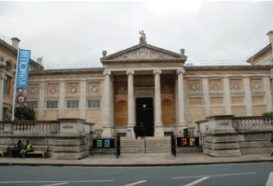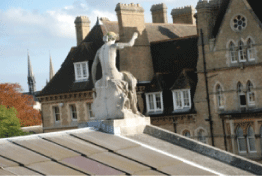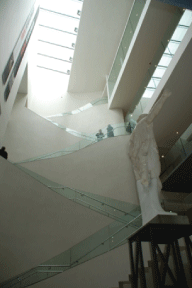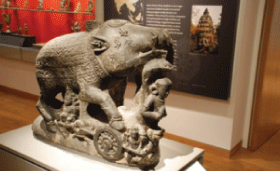 It is always a little dangerous to revisit old friends. What will they be like? Will you still like them when you have not seen them for a long time? It was with some trepidation that I returned to Oxford for the opening of the new Ashmolean Museum on 28th October after a major rebuilding campaign.
It is always a little dangerous to revisit old friends. What will they be like? Will you still like them when you have not seen them for a long time? It was with some trepidation that I returned to Oxford for the opening of the new Ashmolean Museum on 28th October after a major rebuilding campaign.
The Ashmolean played a big part in my undergraduate days. Although I was studying classics – archaeology was not formally taught at Oxford at the time – I nevertheless used to frequent it for lectures by Uncle Ian – Ian Richmond the doyen of Roman archaeologists whom everyone knew and who knew everybody. And there was Christopher Hawkes, Professor of European Prehistory who would always bound onto the stage ten minutes late and then give a stunning lecture challenging all the archaeology orthodoxies of the time. And every Monday evening there were the meetings of the Archaeological Society where we heard wonderful lectures from star speakers such as Brian Hope Taylor on Old Yeavering, and Joseph Needham on Chinese Science. To get to the lectures one had to pass through the galleries and see all the Greek and Roman statues – which soon became familiar friends. But the Ashmolean was a fickle friend. From the front there was a magnificent façade, the masterpiece of C. R. Cockerill of 1845 fronting the Greek statue galleries. Behind there was a ramshackle collection of temporary buildings, erected I gather in the 1920s, and already by the 1950s the roofs were leaking. It was time to pull them all down, leaving just the Cockerill façade and build the main museum from scratch. It was a £61 million project which the Heritage Lottery Fund got going by donating £14 million and the Linbury Trust – one of the Sainsbury’s Trusts – gave a further £10 million. Lots of other trusts chipped in and now the new building is open: the most important opening of a new museum in Britain for a long time.
How Does it Look?
Well, first things first. It has a very good restaurant. All museums these days try to compete with the V & A’s Saatchi and Saatchi advert that it has “an ace caff with a quite nice museum attached” The Ashmolean has a magnificent roof-top restaurant just about hidden by the Cockerill façade but with a marvellous view of the Randolph Hotel opposite and the spires of Balliol and also of the backside of the lady – or is it a gentleman – who stands proudly on top of the pediment of the Cockerill façade, with the lightening conductor running up her backside. I wonder if the sculptor ever realised that the only part of his statue that would ever be exposed to close view would be the rear view. I approached the new display with the deepest foreboding. They flourish the slogan of ‘Crossing Cultures, Crossing Times’, and having devoted my life in trying to sort out the past and put the right cultures into the right period, this seemed to negate everything I stand for. I am glad to say they have totally failed, and that in practice, it is a good old fashioned museum with the Greeks in the Greek gallery and the Romans in the Roman gallery. Though I suppose I can see what they are on about, and would grudgingly admit that they were perhaps a quarter successful. The museum is arranged around two great light wells, the central light well – I think they call it an atrium – and a north-west light well.
I wonder if the sculptor ever realised that the only part of his statue that would ever be exposed to close view would be the rear view. I approached the new display with the deepest foreboding. They flourish the slogan of ‘Crossing Cultures, Crossing Times’, and having devoted my life in trying to sort out the past and put the right cultures into the right period, this seemed to negate everything I stand for. I am glad to say they have totally failed, and that in practice, it is a good old fashioned museum with the Greeks in the Greek gallery and the Romans in the Roman gallery. Though I suppose I can see what they are on about, and would grudgingly admit that they were perhaps a quarter successful. The museum is arranged around two great light wells, the central light well – I think they call it an atrium – and a north-west light well.
 The actual skeleton is quite cunningly arranged in 3m and 6m modules. Some of the galleries are high galleries – 6m high, but intermingled there are low galleries only 3m high, giving as it were a mezzanine floor. This can be stunningly effective. In the Cypriot gallery for instance, you can look up and see through to the rear of the Medieval Cyprus gallery (very small), but medieval Cyprus produced some splendid cartoonish Medieval pottery, though admittedly you have to find a rather hidden lift to go up from the Prehistoric to the Medieval gallery. Their prime example of crossing cultures is that you can go straight from the Roman gallery to the Indian gallery showing the Gandhara Buddhist art that was so much influenced by Alexander and the Romans, though I could not help wondering if this was only a fortuitous archaeology juxtaposition of the two galleries.
The actual skeleton is quite cunningly arranged in 3m and 6m modules. Some of the galleries are high galleries – 6m high, but intermingled there are low galleries only 3m high, giving as it were a mezzanine floor. This can be stunningly effective. In the Cypriot gallery for instance, you can look up and see through to the rear of the Medieval Cyprus gallery (very small), but medieval Cyprus produced some splendid cartoonish Medieval pottery, though admittedly you have to find a rather hidden lift to go up from the Prehistoric to the Medieval gallery. Their prime example of crossing cultures is that you can go straight from the Roman gallery to the Indian gallery showing the Gandhara Buddhist art that was so much influenced by Alexander and the Romans, though I could not help wondering if this was only a fortuitous archaeology juxtaposition of the two galleries.
Many of the sections have an orientation room to point out the cross-cultural connections. There were some very interesting examples in the Chinese room of a Chinese plate with a picture of the Botanic Gardens in Oxford; in other words someone had taken a painting of the Botanic Gardens out to China where it had been painted onto a porcelain plate and then shipped back to Oxford where it is now displayed – a fine crosscultural connection! However, where the ‘Crossing Time’ theme seemed to fail was that there was a break between the antiquities on the ground floor and the Medieval on the second floor. Thus if you wanted to see the Alfred jewel, the prize exhibit of Anglo-Saxon England, you had to go up to the second floor. Though the Medieval gallery is a mixed experience for me: I don’t like Medieval art – it is too pious, too Christian, too stereotyped – but I love the wonderfully barbaric Anglo-Saxon art – all those great cruciform brooches and the saucer brooches, of which the Ashmolean has a superb collection.
Oriental Archaeology
What I had not realised before was the strength of the Ashmolean collection, particularly in Eastern art. I knew that the Ashmolean had a superb collection of Minoan material – Sir Arthur Evans was the Director of the Museum from 1884 – 1908 and they have his collection, the finest collection of Minoan material outside Crete. They also have a fine collection of predynastic Egyptian material and of course the wonderful collection of Greek and Roman statues. What I had not realised was the strength of their Indian, Chinese and Japanese collections.
 Their Islamic material is wonderful – and Islamic collections are very fashionable these days; but their Buddhist material is also superb, beautifully displayed against a yellowish/golden background. And then of course there are the paintings which I must confess I have never really looked at, but I gather that it is a first rate collection. So yes, I think on the whole I rather approved. My old flame is still worthy of admiration. The Ashmolean is the oldest museum in this country, originally based on the Tradescant collection (father and son) which passed to Elias Ashmole who gave it to the University in 1677. But I think its great virtue is that it is a university museum.
Their Islamic material is wonderful – and Islamic collections are very fashionable these days; but their Buddhist material is also superb, beautifully displayed against a yellowish/golden background. And then of course there are the paintings which I must confess I have never really looked at, but I gather that it is a first rate collection. So yes, I think on the whole I rather approved. My old flame is still worthy of admiration. The Ashmolean is the oldest museum in this country, originally based on the Tradescant collection (father and son) which passed to Elias Ashmole who gave it to the University in 1677. But I think its great virtue is that it is a university museum.
Museums in my time have gone steadily down hill as most museums today are aimed at a rather dim eleven year-old school children. The Ashmolean by contrast is aimed at a rather bright Oxford undergraduate, and as a result actually tries to be somewhat intellectual. It claims to be not only the oldest but the best museum in the country outside London. Does it really live up to its claim? I may be biased, but I rather think it does.



